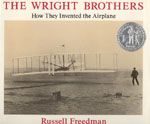Through the Looking Glass Children's Book Reviews
The Wright Brothers: How They Invented the Airplane
Photographer: Wilbur and Orville Wright
Nonfiction
For ages 12 and up
Holiday House, 1991 ISBN: 978-0823408757
From a very early age Orville and Wilbur Wright were very close. They played together and built things together. As they grew up this relationship did not change. Neither brother married or moved out of the family home. They complemented one another and the end result for the brothers was a friendship and companionship that made them happy and left them feeling complete. The end result for the rest of us was an invention which changed the way mankind traveled and saw the world.
It all began when Bishop Wright gave his sons a toy helicopter. The boys played with it until it fell to pieces. They then built several similar toys themselves which flew successfully. However, attempts to make larger versions of the devices did not do as well. As Orville and Wilbur grew up they continued to tinker with mechanical objects and to make things with their hands. They left school when they were still in high school and went on to work first in the printing press business, and then to run a bicycle business of their own.
It was while they were successfully running this business that they heard about the experiments being carried out by several men around the world in the field of aeronautics. The idea of creating a machine that could fly fascinated them and became their new and abiding interest. It wasn?t long before the brothers were spending the off-season away from their shop and down on the sand dunes of Kill Devil Hills on the North Carolina Outer Banks.
Thus began the struggle to solve the great problem of flight, or rather of being able to attain flight. The brothers were soon able to build a glider that would carry a man across the sand dunes at Kill Devil Hills. And yet there were always new problems to overcome before they could move onto the next stage, before they could make a bigger machine, before they could think of adding an engine. There were crashes, days of bad weather, mosquitoes that bit through their clothing, visitors who clearly were there to steal their ideas, and always there was that worry that someone else would get their flying machine into the air first.
The author of this book has written a first class and truly fascinating account of the Wright brothers? achievements. We are given a real sense of the urgency that they felt to get a manned and powered plane into the air, a feeling that they did their best to ignore. We also understand how close they were, and are not surprised to learn that, when Wilbur died at the early age of forty-five, Orville had little heart to continue working on airplanes. We delight in the successes that the brothers made and in the praise and honor they so justly received, once the world truly understood the full import of what they had created. Filled with their photographs, this is a wonderful tribute to two extraordinary, yet very, quiet, humble and unassuming men.
This book was a Newbery Honor winner.




